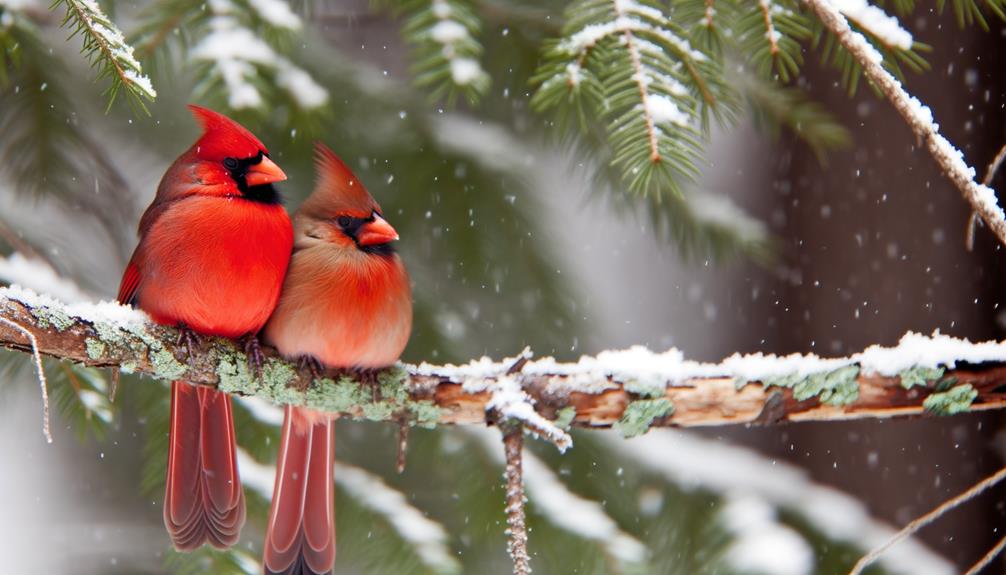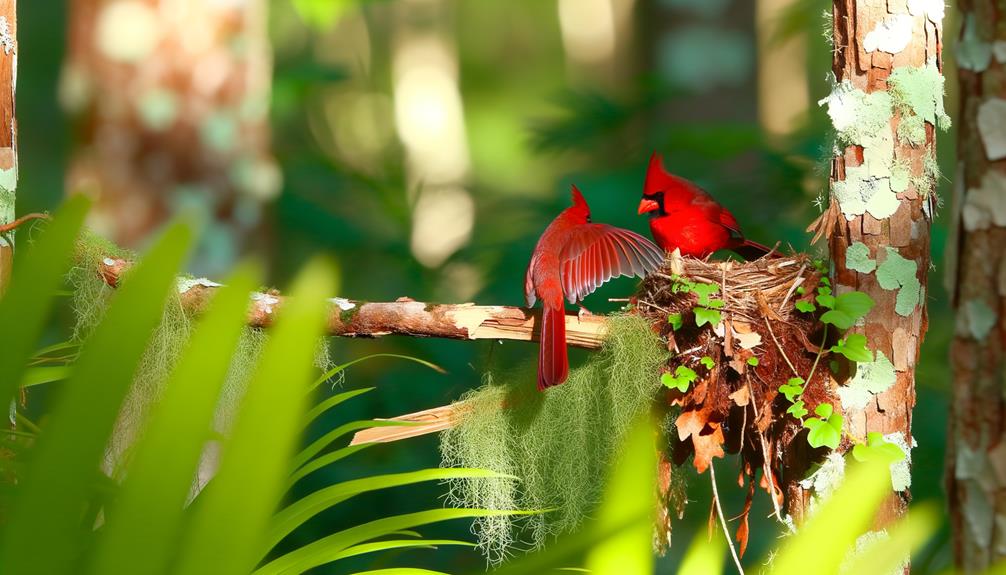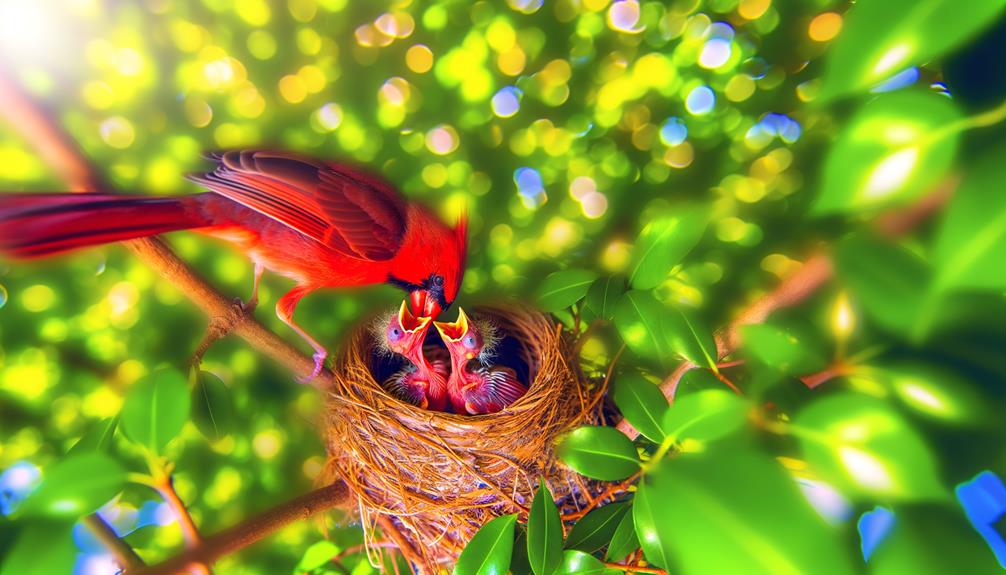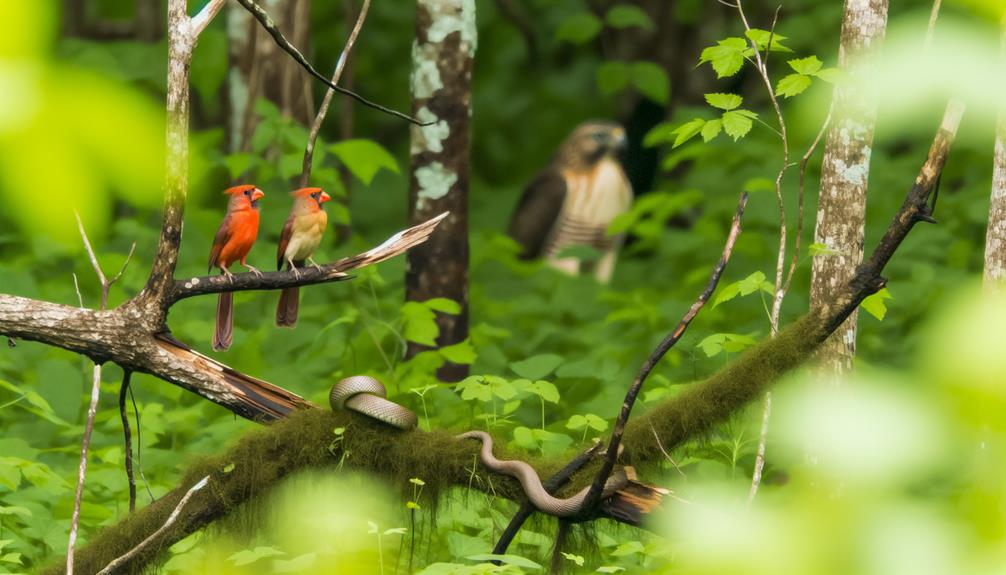A Birdwatcher’s Guide: Do Cardinal Couples Form Lifetime Mates Even If They Do Not Migrate?
You'll be intrigued to know that cardinal couples form lifelong bonds, engaging in behaviors like duets and mutual preening to solidify their relationships. These non-migratory birds fiercely defend their territories all year, ensuring access to local food resources.
They meticulously build nests together, with males gathering materials and females ensuring the safety of their young. Their diet consists of seeds, fruits, and insects, and they face predators like hawks and domestic cats.
Cardinals adapt seasonally, seeking dense shrubs and thickets for refuge. There's much more to explore as you continue.

Key Takeaways
- Cardinal couples engage in lifelong bonds, performing duets and mutual preening to strengthen their relationship.
- They are non-migratory birds, maintaining their territories and utilizing local food resources throughout the year.
- Cardinals defend their territories year-round with aggressive behaviors, ensuring a safe environment for nesting and raising their young.
- They exhibit cooperative behaviors in nest building and raising offspring, with males providing food and females incubating eggs.
- Cardinals adapt to seasonal changes, employing strategies like feather fluffing in winter and dynamic courtship rituals during breeding season.
Lifelong Bonding

From the moment they choose each other, cardinal pairs engage in a series of intricate actions aimed at solidifying their lifelong bond.
You'll notice that they sing duets, with each partner taking turns, creating a harmonious blend that's unique to their relationship.
They also participate in mutual preening, meticulously grooming each other's feathers to reinforce their connection.
When it comes to feeding, the male often shares food with the female, a gesture that strengthens their partnership.
During nesting season, both take part in building the nest, showcasing their teamwork.
These behaviors aren't just rituals; they're essential for maintaining a strong, enduring bond.
You can observe these enchanting behaviors in their natural habitats, a proof of their commitment and freedom.
Non-Migratory Behavior
You'll notice that cardinals don't migrate, choosing instead to defend their territories year-round. They adapt to seasonal changes through varied behaviors and resource management strategies.
This non-migratory lifestyle allows them to fully utilize local food resources, ensuring their survival and the strength of their lifelong bonds.
Year-Round Territory Defense
Despite seasonal changes, Northern Cardinals maintain their territories year-round, showcasing their non-migratory behavior through constant vigilance and boundary defense. You'll see them perched high, surveying their surroundings, always ready to fend off intruders. Their vibrant red plumage isn't just for show; it's a warning to others to stay clear. Both males and females participate actively, employing various calls and displays to mark their territory.
Here's a quick look at their territorial behaviors:
| Behavior | Description |
|---|---|
| Singing | Loud, clear songs to establish presence |
| Displaying | Visual signals like wing flicks and crest raises |
| Chasing | Active pursuit of intruders |
| Nest Guarding | Protecting nesting sites from potential threats |
| Feeding Zones | Defending food sources within their territory |
These behaviors guarantee they maintain control over their chosen domain, providing stability and security.
Seasonal Adaptation Strategies
Not only do Northern Cardinals defend their territories year-round, but they also employ a range of seasonal adaptation strategies to thrive without migrating.
You'll find that they grow denser plumage in winter, providing essential insulation against the cold. Their vibrant red feathers, which are less vibrant in females, serve as camouflage amid autumn foliage.
Additionally, cardinals engage in sunbathing behaviors, using solar radiation to regulate body temperature. During breeding seasons, they build nests in thick shrubs, optimizing protection from predators and harsh weather conditions.
By adapting their behaviors and physical characteristics to seasonal changes, cardinals demonstrate remarkable resilience, ensuring they not only survive but flourish throughout the year.
These strategies highlight an impressive balance between freedom and survival.
Local Food Resource Utilization
Northern Cardinals demonstrate exceptional adaptability and foraging skills by capitalizing on locally available food resources year-round. They showcase their versatility by effectively utilizing various food types to ensure their survival in diverse environments.
Here's how they do it:
- Seed Consumption: Cardinals primarily feed on seeds, especially during winter when other food sources are scarce. Sunflower seeds are a favorite.
- Fruit Foraging: In warmer months, they shift to eating fruits and berries, which provide essential vitamins and hydration.
- Insect Hunting: During the breeding season, they increase their intake of insects to meet the higher protein demands of raising chicks.
Territorial Nature

Observations reveal that cardinal couples fiercely defend their territory, often engaging in aggressive behaviors to ward off intruders. You'll notice they adopt a variety of tactics to guarantee their domain remains secure.
Males are particularly vigilant, frequently singing to assert their presence and deter rivals. During confrontations, they might engage in physical displays like wing flicking and bill snapping. If these warnings go unheeded, cardinals won't hesitate to chase away trespassers.
This territorial imperative guarantees they've sufficient access to resources, such as food and nesting sites, critical for their survival. By maintaining a well-defined territory, cardinal couples can thrive without the stress of constant competition, allowing them to focus on their lifelong bond and shared responsibilities.
Nest Building Together
Cardinal couples work together meticulously to build their nests, using a variety of materials like twigs, grasses, and leaves to create a sturdy and well-camouflaged home for their future offspring. You'll often observe the males gathering materials while the females focus on the architectural aspects, weaving everything tightly.
This collaboration guarantees the nest is:
- Well-hidden: Strategically placed in dense foliage to avoid predators.
- Sturdy: Constructed to withstand varying weather conditions.
- Insulated: Designed to keep warmth in, guaranteeing the eggs develop properly.
Their teamwork is a marvel of natural engineering, showcasing their instinctive skills. By sharing responsibilities, cardinal couples demonstrate a profound connection, guaranteeing their nest is a safe sanctuary.
This cooperative effort highlights their bond and dedication to family.
Raising Offspring

You'll observe that after constructing their nest, cardinal pairs exhibit remarkable cooperation in raising their young.
The female primarily incubates the eggs while the male provides food, ensuring both the female and the hatchlings are well-fed.
This synchronized effort highlights their strong partnership and dedication to nurturing their offspring.
Nest Building Process
When building their nest, cardinal couples meticulously gather twigs, leaves, and grasses, creating a sturdy and well-camouflaged home for their future offspring. You'll observe them selecting materials with precision, ensuring each piece contributes to the nest's structure and concealment.
The process unfolds in three stages:
- Foundation: They start with coarse twigs to form a robust base.
- Insulation: Next, they line the nest with softer materials like leaves and grasses for warmth.
- Camouflage: Finally, they use surrounding foliage to blend the nest seamlessly into the environment.
Each step is critical, reflecting their instinctual drive for security and comfort. You can sense their commitment as they work tirelessly, creating a sanctuary that guarantees the well-being of their young.
Feeding the Young
With unwavering dedication, both parents tirelessly deliver an array of insects and seeds directly into the gaping mouths of their hungry chicks.
You'll notice the male cardinal often scouts for food, bringing back a variety of caterpillars, beetles, and grasshoppers. The female, meanwhile, stays vigilant at the nest, ensuring each chick receives an equal share.
This cooperative dynamic is crucial for the chicks' rapid growth during their initial weeks. As you observe, you'll see how both parents respond to the insistent calls of their young, demonstrating an instinctive commitment to their offspring's survival.
This meticulous care continues until the fledglings are strong enough to leave the nest, ready to face the world on their own.
Communication and Calls
Cardinals exhibit a rich variety of vocalizations, each serving distinct purposes in their social interactions and territorial defense. You'll notice their calls aren't just random noises but essential communication tools.
- Territorial Songs: Males sing from high perches to establish and defend their territory. These songs can be complex, varying in pitch and duration.
- Mate Calls: Both males and females use softer calls to communicate with each other, strengthening their lifelong bond. These calls are often described as chip or tew sounds.
- Alarm Calls: When danger is near, cardinals emit sharp, metallic-sounding calls to alert their mate and other nearby cardinals.
Observing these vocal patterns reveals the cardinals' intricate social structure and their unwavering commitment to one another.
Seasonal Changes

You'll observe that cardinal couples exhibit fascinating behaviors as seasons change. During winter, they adapt by fluffing their feathers for insulation, while in the breeding season, they display dynamic rituals to strengthen their bond.
Nesting site selection becomes essential, with both partners carefully choosing locations that guarantee safety and proximity to food sources.
Adapting to Winter
As winter approaches, you'll notice that Northern Cardinals display a variety of behavioral and physiological adaptations to cope with the harsher conditions. These adaptations secure their survival and well-being during colder months.
Here's what you can expect:
- Feather Fluffing: Cardinals fluff their feathers to trap air, creating an insulating layer that retains body heat.
- Dietary Adjustments: They transition to consuming more seeds and berries, which are rich in fats and proteins, providing necessary energy.
- Territorial Behaviors: Cardinals uphold and defend their territories more vigorously to safeguard food resources, guaranteeing they've access to sufficient sustenance.
These strategies highlight the cardinals' remarkable ability to thrive despite challenging winter environments, showcasing their resilience and adaptability.
Breeding Season Dynamics
During the breeding season, you'll observe Northern Cardinals engaging in elaborate courtship behaviors and nest-building activities, essential for successful reproduction and offspring rearing.
Males display vibrant plumage and sing complex songs to attract females, often feeding them as a part of courtship. This behavior strengthens pair bonds.
Both partners actively participate in constructing the nest using twigs, leaves, and grass. You'll notice the female selecting the material and intricately weaving it, while the male supplies the resources.
These activities are meticulously timed with seasonal changes, ensuring the availability of food and ideal weather conditions.
Nesting Site Selection
Northern Cardinals meticulously choose nesting sites that provide optimal protection and resources, adjusting their selections with the changing seasons to secure the best environment for their eggs and chicks.
You'll observe these birds prefer locations that meet specific criteria:
- Thick Foliage: In spring, they search for dense shrubs or trees to conceal nests from predators.
- Height: They frequently opt for sites 3-10 feet above ground to evade ground-based threats and secure improved surveillance.
- Sunlight Exposure: Cardinals pick areas with moderate sunlight, securing warmth without overheating their young.
Diet and Feeding
Cardinals primarily consume a diverse diet that includes seeds, fruits, and insects, reflecting their adaptability to different food sources throughout the seasons. You'll observe them foraging on the ground or among shrubs, energetically picking at seeds, such as sunflower and safflower. Their strong beaks allow them to crack open even tough seeds with ease.
During warmer months, they supplement their diet with insects like beetles, caterpillars, and grasshoppers, providing essential protein. Fruit consumption, including berries and grapes, offers crucial nutrients and hydration, especially in summer.
Predators and Threats

Several natural predators pose noteworthy threats to cardinals, including hawks, owls, snakes, and domestic cats. You can observe these threats in various environments, where the cardinal's vibrant plumage makes them an easy target.
Here are three key predators:
- Hawks: These raptors have sharp eyesight and swift flight, making them formidable hunters of cardinals in open areas.
- Snakes: Often preying on cardinal nests, snakes consume eggs and fledglings, impacting cardinal populations significantly.
- Domestic Cats: These common pets pose a substantial danger, especially in suburban areas, where they may catch unsuspecting cardinals.
Understanding these threats helps in appreciating the cardinal's resilience and the delicate balance of nature they navigate daily.
Cardinal Habitats
While evading predators, cardinals seek refuge in dense shrubs, woodlands, and thickets where they can find ample cover and nesting sites. These habitats provide them with the essential protection needed to raise their young and maintain their lifelong bonds.
You'll often spot cardinals in suburban gardens, parks, and forest edges, favoring areas with a mix of open spaces and dense vegetation. They're particularly drawn to regions abundant in berry-producing plants and seeds, which form a significant part of their diet.
The dense foliage not only offers safety but also serves as an ideal location for building their nests. By understanding these habitat preferences, you can better appreciate the cardinal's adaptability and resilience in various environments.
Symbolism in Culture

In various cultures, the vibrant red plumage and melodic songs of cardinals have imbued them with rich symbolic meanings, often associated with love, importance, and spiritual guidance. You'll find that cardinals symbolize:
- Love and Devotion: Cardinals, being lifetime mates, are seen as symbols of enduring love and commitment.
- Energy and Significance: Their striking red color signifies energy and the crucial nature of life, acting as a beacon of vitality.
- Spiritual Messages: Many believe that cardinals are messengers from the spiritual domain, offering guidance and comfort.
Observing cardinals, you'll notice their presence in various cultural narratives, showcasing their role not just as birds, but as symbols deeply woven into human experiences and beliefs. Their symbolism resonates with those seeking deeper connections in life.
Conservation Status
Recognizing the cardinal's symbolic importance, it's equally significant to understand their current conservation status in the wild. Fortunately, Northern Cardinals aren't currently listed as threatened or endangered. Their population is stable, thanks to their adaptability to diverse habitats, including woodlands, gardens, and wetlands.
You might notice them frequently in suburban areas where bird feeders provide steady food sources. However, habitat loss and climate change could pose future risks. It's vital to support local conservation efforts and maintain green spaces to guarantee these vibrant birds continue to thrive.
Conclusion
You've now discovered that primary couples form lifelong bonds and remain in their territories year-round. Fascinatingly, around 60% of their offspring survive to adulthood, a sign of their dedicated parenting.
By observing their intricate nest-building and attentive care, you can see why cardinals are symbols of devotion and persistence. With their habitats under threat, understanding and protecting these vibrant birds is essential.
Let's guarantee these striking red jewels continue to grace our backyards and inspire cultural tales.






